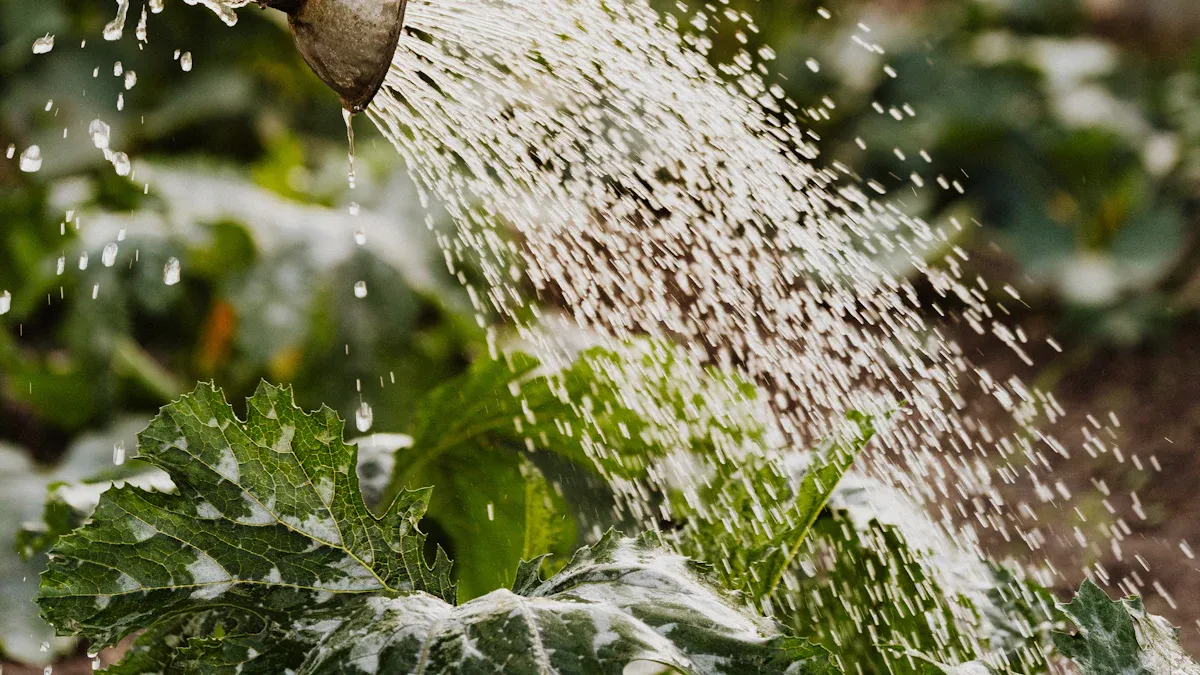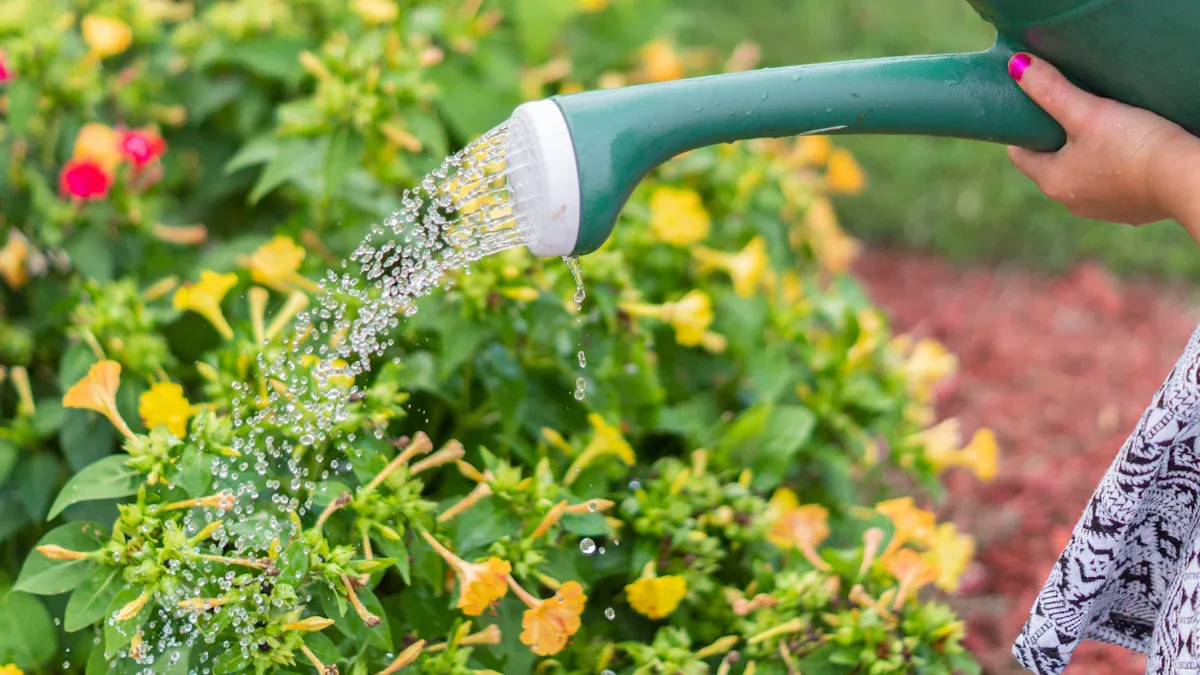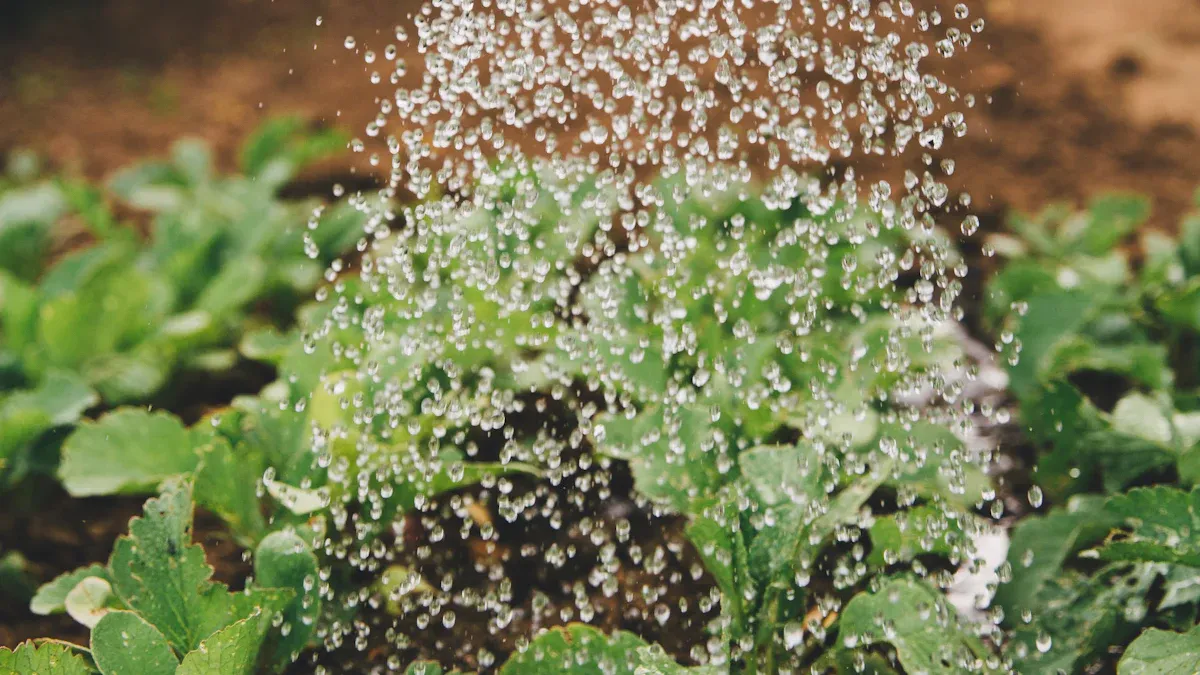
Image Source: pexels
Do you think a simple tool can make a big difference in gardening? The watering can does exactly that. It gives you control over how much water your plants receive, helping you avoid overwatering or underwatering. Its gentle spray mimics rainfall, which keeps delicate plants safe from damage. Plus, it’s portable, making it easy for you to reach every corner of your garden. Whether you're caring for indoor plants or outdoor beds, this timeless tool remains a favorite among gardeners for its reliability and ease of use.
Key Takeaways
A watering can helps you control how much water plants get. This stops overwatering or underwatering, keeping plants healthy.
Its soft spray is like gentle rain, perfect for fragile plants such as seedlings or indoor ones.
Watering cans are easy to carry and work for any garden size, from tiny pots to big garden beds.
Pick a watering can based on your garden size and plant types. Look at things like the spout shape and how much water it holds.
Using a watering can helps you focus on your plants. It lets you bond with them and take better care of them.
Why a Watering Can is a Must-Have Tool

Image Source: pexels
Precision and Control in Watering
Have you ever struggled to water your plants evenly? A watering can solves that problem by giving you complete control over how much water each plant gets. Unlike hoses, which can sometimes flood the soil, a watering can allows you to target specific areas with precision. You can direct the spout right at the base of your plants, ensuring the water reaches their roots where it’s needed most. This level of control helps prevent overwatering, which can lead to root rot, and underwatering, which can leave your plants thirsty.
If you’re caring for potted plants or small garden beds, this tool is a game-changer. It’s especially useful when you’re working with plants that have different watering needs. For example, succulents require less water than ferns. With a watering can, you can easily adjust the amount of water you give to each plant, keeping them all happy and healthy.
Gentle Watering for Delicate Plants
Some plants are like babies—they need a gentle touch. Seedlings, for instance, can’t handle the force of a garden hose. The strong stream can wash away soil or even damage their fragile stems. That’s where a watering can shines. Its spout, often equipped with a rose attachment, creates a soft, rain-like spray. This gentle flow mimics natural rainfall, making it perfect for delicate plants.
You’ll also find this feature handy for indoor plants. Many houseplants, like orchids or African violets, don’t like water splashing on their leaves. A watering can lets you water the soil directly without disturbing the foliage. This not only keeps your plants safe but also reduces the risk of fungal diseases caused by wet leaves.
Portability and Versatility
One of the best things about a watering can is how portable it is. You can carry it anywhere, whether you’re watering a hanging basket on your porch or a flower bed at the far end of your yard. Unlike hoses, which can be heavy and hard to maneuver, a watering can is lightweight and easy to handle. This makes it ideal for gardeners of all ages, including kids and seniors.
Its versatility is another reason why it’s a must-have. You can use it for everything from watering indoor plants to hydrating outdoor vegetables. Some gardeners even use their watering cans to mix and apply liquid fertilizers. Whether you have a small balcony garden or a sprawling backyard, there’s a watering can that fits your needs.
Factors to Consider Before Using a Watering Can
Garden Size and Layout
Your garden’s size and layout play a big role in choosing the right watering can. If you have a small balcony garden or a few potted plants, a compact watering can with a narrow spout works best. It’s lightweight and easy to maneuver in tight spaces. For larger gardens, you’ll need a watering can with a bigger capacity. This saves you from making multiple trips to refill it.
Think about accessibility too. Are there hard-to-reach areas like hanging baskets or raised beds? A watering can with a long spout can help you reach those spots without spilling water everywhere. If your garden has uneven terrain, portability becomes even more important. A sturdy handle and balanced design make carrying a full watering can much easier.
Tip: For sprawling gardens, consider using multiple watering cans to distribute the weight evenly and reduce strain on your arms.
Plant Types and Their Watering Needs
Different plants have different watering requirements. Succulents and cacti thrive with less water, while ferns and tropical plants need frequent hydration. A watering can lets you tailor your approach to each plant’s needs. For delicate plants like seedlings, use a can with a rose attachment. This creates a gentle spray that won’t disturb the soil or damage fragile stems.
Indoor plants often require precision. A watering can with a narrow spout allows you to water the soil directly without splashing water on furniture or leaves. Outdoor plants, especially those in large beds, benefit from a can with a wider spout for faster coverage.
Frequency and Method of Watering
How often you water depends on the plant species and climate. Some plants, like Moringa oleifera, grow best when watered every 10 days. Others may need weekly hydration. Using a watering can gives you control over the amount and frequency of water applied.
Here’s a quick look at optimal watering frequencies for Moringa species:
Plant Species | Irrigation Frequency | Mean Plant Height (cm) | Fresh Weight of Leaves (g) |
Moringa oleifera | Every 10 days | 29.8 - 94.3 | 2.9 - 34.2 |
Moringa peregrina | Every 10 days | 20.9 - 78.5 | 2.7 - 18.9 |
For best results, water early in the morning or late in the evening. This reduces evaporation and ensures the water reaches the roots. Avoid wetting the leaves, as this can lead to fungal diseases. A watering can helps you target the soil directly, making your watering routine more efficient.
Watering Can vs. Other Watering Methods
Comparing Watering Cans and Hoses
When it comes to watering your plants, you might wonder whether a watering can or a hose is the better choice. Each has its strengths, but they serve different purposes. A watering can gives you precise control over how much water each plant gets. You can target the roots directly, which helps avoid overwatering and keeps the leaves dry. This is especially important for indoor plants or delicate seedlings that don’t like water sitting on their foliage.
On the other hand, hoses are great for covering larger areas quickly. However, they can be tricky to control. A strong stream of water from a hose might flood the soil or damage fragile plants. Plus, hoses tend to use more water overall. According to research, traditional watering methods like hoses often result in higher water usage compared to more controlled methods. For example, soaker hoses can save up to 30% more water than traditional watering techniques, but they still lack the precision of a watering can.
Method | Water Conservation | Efficiency Comparison |
Soaker Hose | 30% water savings | More efficient |
Traditional Watering | Higher water usage | Less efficient |
If you’re working with a small garden or potted plants, a watering can is your best bet. It’s portable, easy to handle, and lets you water with care. For larger gardens, you might combine a hose for general watering and a watering can for specific plants that need extra attention.
Watering Cans vs. Sprinkler Systems
Sprinkler systems are another popular option, especially for large lawns or garden beds. They’re convenient because they can cover a wide area without much effort on your part. You just set them up, turn them on, and let them do the work. But here’s the catch: sprinklers aren’t very efficient when it comes to water usage. A lot of water gets lost to evaporation, especially on hot or windy days. In fact, studies show that sprinkler systems can waste significant amounts of water compared to more targeted methods like drip irrigation.
A watering can, on the other hand, delivers water directly to the soil. This minimizes evaporation and ensures the water reaches the roots where it’s needed most. While sprinklers are great for large spaces, they’re not ideal for plants with specific watering needs. If you’re growing vegetables or flowers that require careful attention, a watering can gives you the control you need to keep them healthy.
Pros and Cons of Each Method
Each watering method has its pros and cons, and the best choice depends on your garden’s size, layout, and the types of plants you’re growing. Here’s a quick breakdown to help you decide:
Watering Can
Pros: Precise, portable, and ideal for small gardens or potted plants. It conserves water by targeting specific areas and reduces the risk of overwatering.
Cons: Time-consuming for large gardens and requires manual effort.
Hose
Pros: Covers large areas quickly and is easy to use for outdoor spaces.
Cons: Less precise, higher water usage, and can damage delicate plants with strong water pressure.
Sprinkler System
Pros: Convenient for large lawns or garden beds. It saves time and effort.
Cons: High water loss through evaporation and less effective for plants with specific watering needs.
If you’re looking for a balance between efficiency and care, a watering can is a versatile tool that works well for most gardening tasks. It’s especially useful for gardeners who want to conserve water and give their plants the attention they deserve.
Choosing the Right Watering Can

Image Source: unsplash
Material: Plastic, Metal, or Ceramic
When picking a watering can, the material matters more than you might think. Each type—plastic, metal, or ceramic—has its own perks. A plastic watering can is lightweight and easy to carry, making it perfect for indoor plants or small gardens. It’s also budget-friendly and comes in a variety of colors and designs. However, it may not last as long if left in the sun for extended periods.
Metal watering cans, on the other hand, are durable and stylish. They’re great for outdoor use and can handle rough conditions. Some even come with a rust-resistant coating, which adds to their longevity. Ceramic watering cans are less common but offer a unique, decorative touch. They’re heavier and more fragile, so they’re best suited for indoor use or as a display piece.
Tip: If you’re looking for something long-lasting and versatile, a metal watering can with a protective coating is a solid choice.
Size and Capacity for Different Needs
The size of your watering can should match your gardening needs. For indoor plants or small spaces, a compact can with a capacity of 1-2 liters works well. It’s easy to handle and won’t take up much storage space. For larger gardens, you’ll need a bigger can—something that holds 5-10 liters. This saves you from making multiple trips to refill.
Think about how much weight you’re comfortable carrying. A full watering can can get heavy, especially if you’re watering a large area. If you have mobility issues or prefer lighter loads, opt for a smaller size and refill as needed.
Spout Design and Functionality
The spout design plays a big role in how effectively you can water your plants. A long, narrow spout is ideal for precision watering. It helps you reach tight spots, like the base of a plant or hanging baskets, without spilling. For delicate plants or seedlings, look for a spout with a rose attachment. This creates a gentle, rain-like spray that won’t disturb the soil.
Wide spouts are better for covering larger areas quickly. They’re great for outdoor garden beds where speed matters more than precision. Some watering cans even come with adjustable spouts, giving you the flexibility to switch between a fine spray and a steady stream.
Note: Choose a spout that matches your plants’ needs. A versatile design can make your watering routine much easier.
Practical Insights from Gardeners
Real-Life Benefits of Using a Watering Can
Using a watering can gives you more control over your watering habits. Many gardeners have shared how this tool helped them understand their plants better. For example, a study on urban gardening showed that gardeners learned to monitor their water usage more effectively. One participant said, "I learned that the pressure of the water reflects how much water is used and how long I have to water." This insight helped them adjust their watering practices, ensuring their plants received just the right amount of hydration.
A watering can also encourages mindfulness. When you water by hand, you pay closer attention to each plant’s needs. You notice which ones are thriving and which might need extra care. This hands-on approach can improve your gardening skills over time. Some gardeners even use watering cans to experiment with liquid fertilizers, giving their plants a nutrient boost while keeping water usage under control.
How It Simplifies Gardening Routines
A watering can makes your gardening routine easier and more efficient. Its portability lets you move around your garden without hassle. You can water hanging baskets, raised beds, or potted plants without dragging a heavy hose. This flexibility is especially helpful if your garden has hard-to-reach spots.
Here’s why gardeners love watering cans:
They’re lightweight and easy to carry, even when full.
They allow precise watering, reducing waste and preventing overwatering.
They’re versatile, working well for indoor plants, outdoor beds, and even liquid fertilizers.
Tip: If you’re new to gardening, start with a small watering can. It’s easier to handle and helps you learn the basics of plant care.
While some gardeners prefer hoses or sprinklers for larger areas, many find watering cans more practical for smaller gardens. They’re simple to use and don’t require setup or maintenance. Plus, they help you connect with your plants on a deeper level, turning watering into a calming, meditative activity.
A watering can is more than just a gardening tool. It helps you water plants with precision, keeps delicate ones safe, and reduces waste. You can use it for indoor pots, outdoor beds, or even hanging baskets. Its portability and versatility make it perfect for gardens of all sizes.
If you want better control over your watering routine, this tool is your best choice. It simplifies plant care and helps you connect with your garden. Pick one that suits your needs, and you’ll see how much easier gardening becomes.
FAQ
How do I choose the right watering can for my garden?
Pick one based on your garden size and plant types. For small spaces, go for a compact can. For larger gardens, choose one with a bigger capacity. Look for features like a long spout or rose attachment for precision watering.
Can I use a watering can for fertilizing plants?
Absolutely! Mix liquid fertilizer with water in your watering can. Follow the instructions on the fertilizer label for proper dilution. This method ensures even distribution and helps your plants absorb nutrients effectively.
How often should I clean my watering can?
Clean it every few weeks or after using liquid fertilizers. Rinse thoroughly to prevent mold or algae buildup. Regular cleaning keeps your watering can in good condition and ensures your plants stay healthy.
Is a metal watering can better than a plastic one?
Metal cans last longer and look stylish. Plastic ones are lightweight and easier to carry. Choose metal for outdoor use and plastic for indoor plants. Both work well, so pick the one that suits your needs.
What’s the best way to water delicate plants?
Use a watering can with a rose attachment. It creates a gentle spray that mimics rainfall. Aim for the soil, not the leaves, to avoid damaging fragile stems or causing fungal issues.















